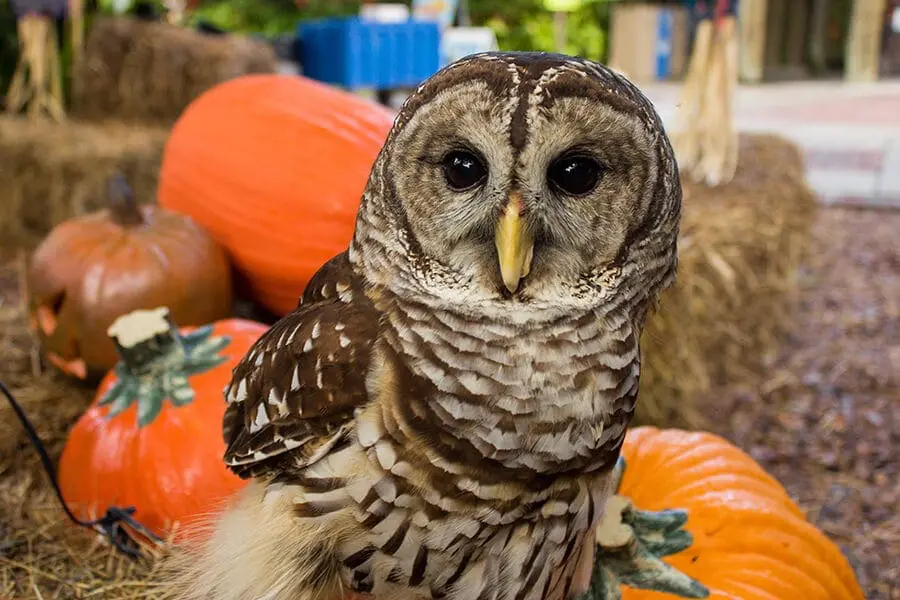

Our barred owl, Errol, ready to celebrate Halloween.
Owls have long been associated with Halloween, and it’s easy to see why. Their wide eyes, horn-like tufts and piercing nocturnal cries are all characteristics one might expect of witches or goblins. In reality, these nocturnal predators are extremely helpful to us. They are excellent pest control—their favorite foods include mice, rats, skunks, snakes and insects. Without owls, our ecosystem would struggle to stay in balance.
The Zoo is home to four owls, all of which were found wounded in the wild and rehabilitated at wildlife centers. None of these birds would likely survive in the wild due to the extent of their injuries.
Errol is a barred owl who arrived on October 1, 2007. We don’t have any information about his injuries. Though Errol can be a bit timid, he is a very calm and patient bird. He loves to be pampered—one of Errol’s favorite activities is perching on keeper Micaela’s glove while she preens the feathers on his head!
Our great horned owl, Horatio, came to the Zoo on December 21, 2011. She was found on the ground with a wing injury as a nestling during a cold snap at the Suntree golf course. Known for her “sassiness,” Horatio is popular with Zoo staff and volunteers for her vocal abilities and can often be heard making a variety of sounds while watching the world from her perch by the Paws On touch tank. She loves to explore every part of her perching, including the tops of her shelter. Guests are often taken aback by the intense stare she gives with her striking golden-yellow eyes. On hot days, keepers will spray Horatio with mist and she always come close, spreading her wings out to soak it all in. She also loves shredding enrichment items, quickly turning paper or leaves into confetti!
Eastern screech owls Stallone and Owlbert came to us in 2015 on separate occasions. Stallone was found in the Moss Park area of Orlando, where a dog had pulled him out of a bush. He was taken to Back to Nature Wildlife Refuge, then transferred to the Audubon Center for Birds of Prey before finding his permanent home at the Zoo. Owlbert was discovered as a juvenile on Minton Road in Palm Bay. He was brought to Florida Wildlife Hospital and Sanctuary with a closed fracture to his right radius and ulna, which healed, but he never regained the ability to fully extend his wing due to probable nerve damage. At first glance, many people think these little guys are babies, but they are, in fact, the smallest species of owl found in Florida! While Stallone and Owlbert are very similar in size and coloration, they are very easy to tell apart by their attitude. Stallone is quite comfortable going out with his keepers and meeting guests and is always eager to take a snack of insects from our fingers! Owlbert is a bit shyer and prefers to eat his meals on his perches while watching people from a distance. Both love hearing recorded sounds of other wildlife, and will sometimes even call back to some of the animals like wolves and other screech owls!
Owls are best seen and heard at dawn and dusk. Though they’re fairly common in suburban areas, a forest’s edge is probably the best place to look for these elusive birds of prey. Keep your eyes and ears open—you might be surprised by who you find!
